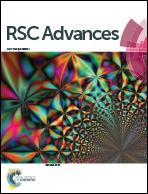5-Aminolevulinic acid functionalized boron-nitride and carbon nanotubes as drug delivery vehicles for skin anticancer drugs: a theoretical study
Abstract
An improved delivery of 5-aminolevulinic acid (ALA), a drug used for skin anticancer therapy depends on the nature of the drug carrier. The electronic structure and properties of ALA functionalized zigzag and armchair boron-nitride nanotubes (BNNTs) are studied using density functional theory (DFT) calculations at the B3LYP/6-31G(d) level. A comparison has been made with the results of the corresponding carbon nanotube (CNT)–ALA complexes. The computed interaction energies and changes in Gibbs free energies suggest that the functionalization of BNNTs with ALA are more favorable than those of CNTs. IR vibrational analyses of some important chemical bonds in BNNT–ALA and CNT–ALA complexes have been made to explore any changes in the binding characteristics of the drug molecule after its attachment to the nanotubes. The calculated NBO charges, HOMO–LUMO gaps, and DOS spectra of the pristine and ALA functionalized nanotubes indicate that the end functionalization of the nanotubes by the ALA molecule does not alter the electronic properties of the pristine nanostructures or ALA significantly. The attachment of the drug molecule to the nanotube changes the polarity of the pristine nanotube as shown by the computed dipole moment values. The stabilities and reactivities of these nanotube–drug complexes have been tested from the magnitudes of the chemical reactivity descriptors such as chemical potential, hardness, and electrophilicity index. The effects of the protein core and aqueous environment on the BNNT–ALA interaction energies have been investigated by using the IEF-PCM model. The computed solvation energies show that the solubilities of ALA functionalized BNNTs are enhanced to a greater extent compared to the pristine ones. BNNTs can thus act as a drug delivery vehicle for the transportation of skin anticancer drugs within the biological system.


 Please wait while we load your content...
Please wait while we load your content...